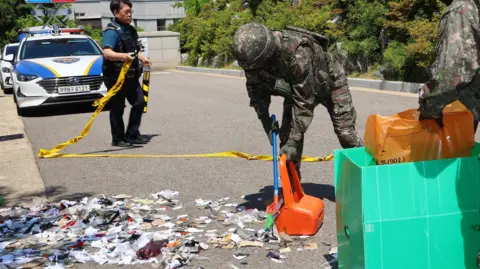
The Korean Peninsula has become a battleground for a peculiar kind of warfare – a balloon propaganda war. Fueled by a recent spike in cross-border tensions, North Korea has launched a wave of weaponized garbage, sending balloons laden with waste crashing down on South Korea. This bizarre tactic is a direct response to a campaign by North Korean defectors and South Korean activists who have been sending balloons northward carrying humanitarian aid and messages critical of the North Korean regime.

Beyond Trash: A Window into North Korea’s Plight
Over 1,500 balloons overflowing with waste have descended upon South Korea since May. A closer look at the contents paints a troubling picture of North Korea’s internal struggles:
- Parasitic Threat: Analysis of the soil contained within the balloons revealed a disturbing truth – roundworms, whipworms, and threadworms. This parasitic infestation is likely a consequence of North Korea’s reliance on human waste as fertilizer due to a lack of readily available chemical alternatives. While health officials have downplayed the immediate threat of infection, the discovery raises serious concerns about sanitation and public health in North Korea. North Korea’s struggling economy likely contributes to these sanitation issues, limiting its ability to invest in proper sewage systems and waste treatment facilities.
- Desecrated Western Clothing: Donated clothes featuring beloved characters like Mickey Mouse, Winnie the Pooh, and Hello Kitty were found slashed and stuffed into the balloons. This act of destruction can be interpreted as a symbolic rejection of South Korean culture and external influence. North Korea’s government has long sought to control the flow of information and cultural products into the country, fearing that exposure to outside ideas could threaten its totalitarian grip on power. The slashing of the donated clothes serves as a potent symbol of this resistance to external influence.
- Patched-up Garments: The presence of heavily patched children’s clothing serves as a heartbreaking testament to the economic hardship faced by many North Koreans, where even basic necessities are in short supply. The poor quality and patched nature of the clothes suggests a society struggling to meet the basic needs of its citizens. This economic hardship is likely due to a combination of factors, including North Korea’s isolationist policies, its reliance on a centrally planned economy, and international sanctions.
READ ALSO: https://thecrux.com.ng/north-korea-sends-unusual-gift-to-south-balloons-carrying-feces-photos/

South Korea Responds: Propaganda War Escalates
South Korea has not taken this attack lying down. They have countered with a barrage of K-pop music and news broadcasts booming across the border from powerful loudspeakers. Military officials have issued warnings to citizens, urging them to avoid the balloons and their contents. The fear is not just of potential infection, but also of propaganda materials that might be hidden within the trash.
A Conflict Steeped in History
This balloon propaganda war is merely the latest chapter in the long and complex relationship between the two Koreas. Defectors and activists in the South have a long history of using balloons to send information and critical messages across the heavily fortified border. In the past, these balloons have carried everything from cash and banned media content to Choco Pies, a popular South Korean snack forbidden in the North. North Korea, unsurprisingly, views these activities as a violation of their sovereignty and a direct attack on their regime.
The recent escalation highlights the ongoing struggle for dominance and the simmering animosity that continues to divide the Korean Peninsula.










